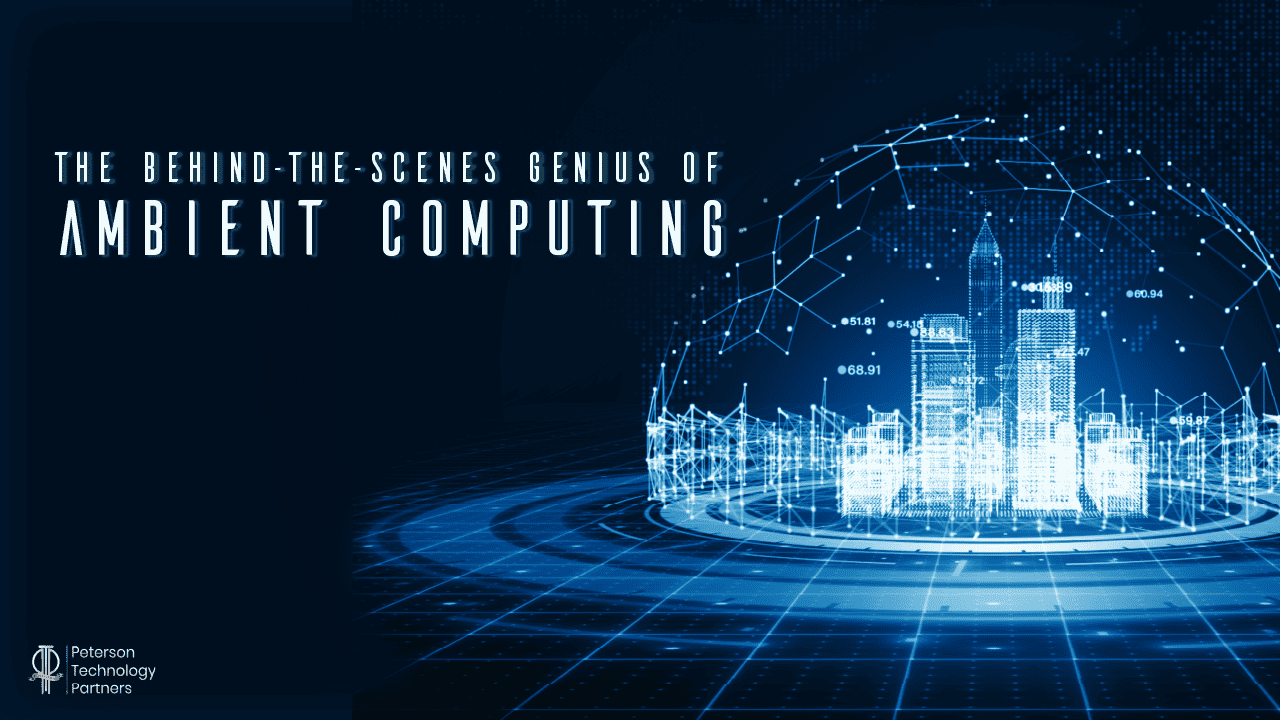In 1991, Mark Weiser, then head of Xerox’s PARC computer science laboratory, wrote an article in Scientific American about what he called “ubiquitous computing.” He was describing a technology whereby computers fade into the background of our awareness while still benefiting us – technology that’s invisible but useful.
Weiser’s concept has grown into what many today call Ambient Computing. However, it can be known by other names as well – ambient intelligence and pervasive computing are among the more common. It is a broad concept to describe an environment of smart devices, powered by AI and ML, working together to deliver a specific result without the need for human intervention or command.
“The most profound technologies are those that…weave themselves into the fabric of everyday life until they are indistinguishable from it.” – Mark Weiser
To get a better understanding of ambient computing, consider the technologies and paradigms that encompass it:
- Zero UI – Currently, most of our interaction with computers involves clicking, typing, or touching a screen. Zero UI (user interface) is a paradigm where we instead interact with our voices, eyes, or body movements. For example, Amazon’s voice-activated Alexa or Magic Leap’s immersive Augmented Reality devices. Eventually, we may even be able to interact with nothing more than our thoughts.
- The Internet of Things – Ambient computing happens in the interaction between us and our connected devices, IoT is the framework for those devices. Indeed, ambient computing is probably not possible without IoT. There are currently 15 billion IoT-connected devices, though that number will nearly double by 2030.
- Edge Computing –Simply stated, edge computing is data analysis and storage at or near the source. Given the massive amounts of data that are being constantly produced, the speed at which it is processed is a vital component of Ambient Computing. Check out a recent PTP Report about Edge Computing for further details.
- Natural Language Processing (NLP) – Perhaps the most visible advancements in language-based AI over the past few years have been the ability for computers to process language like humans, both in speech and the written word. The most well-known example of the latter is ChatGPT, which is so good at writing like a human it is being banned by colleges for fear of plagiarism. And although the aim of Ambient Computing is for our devices to be nearly invisible, those we do interact with will be as if we were interacting with a human. NLP makes that possible.
- Digital Mesh – Ambient Computing means we will be spiders in our invisible web of interconnected devices working behind the scenes. The digital mesh is that interconnectivity. The emergence of 5G technology should allow for ambient networks for years to come. With speeds capable of 15 or 20 Gbps, 5G has already transformed entire economies.
The future that ambient computing promises sound like pure science fiction – the complete transformation of our environment with intelligent, adaptive, and autonomous computers that are everywhere, yet don’t seem to be there at all.
Yet, though the idea of an invisible digital environment that we naturally interact with seems farfetched, ambient computing is anything but fantasy. Currently, it has a global market value of over $500 million, a figure that is expected to grow to nearly $3.5 billion over the next 10 years for a CAGR of almost 20%. Over half of the Asia-Pacific retail market will have adopted ambient computing by 2025.
And those figures may prove to have been underestimated. If the likes of Amazon and Google have any say, we will have large-scale implantation of ambient computing sooner rather than later.
For Google, ambient computing has been an “aggressive” part of its overall strategy since 2019. During its 2022 I/O keynote, Rick Osterloh, Google’s SVP of Devices and Services, reaffirmed the company’s focus on ambient computing. “People don’t want to spend their life fussing with technology. An ambient approach gets the tech out of your way so you can live your life while getting the help you need,” he said.
Likewise, Amazon has focused much of its attention on creating ambient computing environments. The AI that powers its Alexa just happens to be one of the most complex and sophisticated in the world. “A driving force behind ambient intelligence is Alexa’s AI, and it powers everything we build,” said Vishal Sharma, Amazon’s VP of Alexa’s AI.
Conclusion
In an era known for the incredibly rapid growth of technology and disruption, it is somewhat ironic that the goal of ambient computing is quite the opposite. Instead of interrupting, ambient computing will simply surround us while predicting and meeting our needs in ways we haven’t even considered yet. Ambient computing, coupled with the IoT and ML, will continue to transform how we live and conduct business in the not-so-distant future and beyond.
Are you looking for a job in Information Technology?
See all of our current openings here!
About the Company:
Peterson Technology Partners (PTP) has partnered with some of the biggest Fortune brands to offer excellence of service and best-in-class team building for the last 25 years.
PTP’s diverse and global team of recruiting, consulting, and project development experts specialize in a variety of IT competencies which include:
- Cybersecurity
- DevOps
- Cloud Computing
- Data Science
- AI/ML
- Salesforce Optimization
- VR/AR
Peterson Technology Partners is an equal opportunities employer. As an industry leader in IT consulting and recruitment, specializing in diversity hiring, we aim to help our clients build equitable workplaces.





 Work with us
Work with us